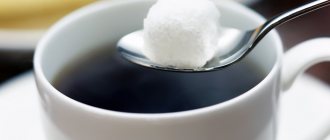Useful tips
Coffee is undoubtedly one of the most popular soft drinks
on our planet, the addiction to which begins for many at a fairly young age.
Involuntarily, a completely logical question arises - how does consuming large amounts of coffee and its various variations affect how much a person weighs?
? How many calories are in a regular cup of ground coffee? What about instant?
Finally, how do various additives, such as milk or sugar,
? Now you will find out the answers to all these questions.
How many calories are in a spoon of coffee?
Calorie content of ground coffee
Coffee contains an extremely small amount of calories, so this drink in its pure form is not one of those that will add extra pounds. This can be proven using banal mathematics. And we'll start with ground coffee. But first we need the following information: one teaspoon
ground coffee holds approximately 4 grams (if you scoop up coffee without a slide) or 5-6 grams of product (if you scoop up a spoon of coffee with a slide).
Next, in order not to be unfounded, we recommend picking up a package of natural ground coffee. Read the nutritional
, which is usually present on the packaging or on an additional sticker placed on a pack of coffee.
Calorie content of one spoon of ground coffee
From this information it is clear that the calorie content of ground coffee is 202 kilocalories per 100 grams of product. Thus, one level spoon of ground coffee contains about 8 kilocalories, and one heaped spoon of ground coffee contains approximately 12 kilocalories.
The benefits and harms of coffee
Why do doctors sometimes recommend including coffee in your diet, while some are asked to refrain from drinking the aromatic drink? The benefits of coffee for the body are invaluable and consist of the following properties:
- increased performance;
- relief from muscle pain after exercise;
- increase in the number of liver enzymes;
- reducing the risk of Alzheimer's disease, type 2 diabetes, gout and cancer;
- protection against free radicals that destroy healthy cells and accelerate the aging process;
- improving gallbladder function and reducing the risk of gallstone formation;
- antibacterial effect, which helps reduce the risk of caries and other dental diseases.
All of the above properties are more characteristic of boiled black coffee, without sweeteners and cream. Green coffee is also considered beneficial.
Photo source: shutterstock.com
But the popular drink can bring more than just benefits. Sometimes it can cause harm if there are contraindications. The harm of coffee to human health is manifested in the following properties:
- disruption of the stomach and pancreas (especially if you drink coffee on an empty stomach);
- difficulty in the work of platelets, which help stop bleeding by clogging the damaged vessel;
- increased blood pressure;
- increased risk of osteoporosis and insomnia (if you drink coffee at night);
- increased anxiety and stress.
Coffee can be especially harmful to women's health, as it can provoke mastopathy. With this disease, lumps form in the mammary glands, which increase in size and hurt during menstruation. All of the above negative properties of the drink manifest themselves mainly when it is consumed on an empty stomach or when the daily norm is exceeded. Don't forget about this if you like to treat yourself to black coffee, latte or espresso.
ABC RECOMMENDS
Not so harmful: 7 myths about caffeine that are still believed
How many calories are in coffee without sugar?
How many calories are in a cup of coffee
So now we know that a teaspoon of pure ground coffee contains approximately 8-12 kilocalories, while a teaspoon
instant coffee contains about 2.5-3.5 kilocalories of product. Does the number of calories change during the final preparation of the product, that is, when preparing a coffee drink?
The answer is clear - if it changes, then only to a lesser extent. And these changes are extremely minor.
How many calories are in one cup of ground coffee?
It's very simple - the answer depends on the type of coffee drink. Take, for example, espresso, which is usually brewed from freshly ground coffee.
. Classic espresso is 7-10 grams of product per approximately 30 grams of water. Thus, a cup of espresso without milk and sugar will add 14 to 20 kilocalories to your body.
Fans of double espresso (doppio), which is essentially the same espresso, only with double the amount
water and coffee (that is, approximately 60 grams of water for 14-20 grams of coffee), consumed with one serving of the drink without additives from 28 to 40 kilocalories.
Americano is a coffee drink for those who do not like a very concentrated coffee taste. Essentially, an Americano is a highly diluted espresso or double espresso. Moreover, according to the classic cooking
, it can be diluted in almost half a liter of water. Thus, the calorie content of one cup of classic Americano made from ground coffee is the same 14-20 kilocalories.
How many calories are in one cup of instant coffee drink?
The nutritional energy value of one cup of coffee drink made from instant coffee is extremely scanty
, although it also directly depends on its strength. Usually coffee is diluted in one hundred grams of water. Added one spoon of coffee - consumed about two kilocalories; two spoons – 4 kilocalories.
It is well known that the recommended calorie intake per day for women is 2000 kilocalories, and for men – 2500 kilocalories. Of course, these are average data
, since this norm depends on age, body weight, type of activity, health status, climate and many, many other factors.
Conclusion: then a couple of cups of coffee without additives
per day do not pose any danger in terms of the risk of gaining excess weight.
Daily coffee consumption
The daily intake of caffeine for adult women and men is 400 mg, which roughly corresponds to 3 glasses of an invigorating drink. With this volume, no adverse reactions from the central nervous and cardiovascular systems are observed.
Photo source: shutterstock.com
Scientists (children under 16 years of age and pregnant women) caffeine intake should not exceed 300 mg per day, and ideally no more than 200 mg. However, according to the results of statistical studies, modern people consume significantly more caffeine than recommended, and in most cases there are no side effects. But it is still worth remembering that excessive coffee consumption puts a high burden on the kidneys and heart.
ABC RECOMMENDS
How many cups of coffee a day prolongs life?
Calorie content of coffee with sugar
How many calories are in coffee with sugar?
Not everyone likes the bitter taste of pure ground or instant coffee, so they drink it with additives. The most popular additive is, without a doubt, granulated sugar.
Before you estimate how many kilocalories one teaspoon of sugar adds to a coffee drink, you should remember how many grams of granulated sugar
fits in this spoon. And the data is as follows: a level teaspoon of sugar is about 5 grams, and a heaped teaspoon is 7 grams.
How many calories are in a spoonful of sugar?
The calorie content of granulated sugar is 387 kilocalories per 100 grams of product; means 1 level teaspoon of sugar
contains approximately 19 kilocalories; the number of kilocalories in a heaped teaspoon of granulated sugar is approximately 27 kilocalories.
For clarity: one cup of espresso contains an average of 63 kilocalories - for one cup, this is not so much. But if you consume two or even three servings a day
, then you will gain 189 kilocalories. And if you add milk or cream, then even more. How much more?
Calorie content in kcal in a mug of black coffee with and without additives
The fresher the roast, the higher the calorie content of the coffee.
Coffee beans contain sugars and fats, as well as some protein, and if the roast is fresh enough, this will only increase the calorie content. For example, freshly roasted and ground coffee beans without added sugar can provide an increase of 0.5-1 kcal per 200 ml (mug of drink).
The situation with sugar is somewhat different. It all comes down to portions. A teaspoon without a slide accounts for 18-20 kcal, with a larger teaspoon - 26-28 kcal. If you want to add spices to your coffee, keep in mind that even 1 g gives an increase in calorie content:
- dry ginger – 1 kcal/1 g;
- cinnamon – 2.5 kcal/1 g;
- vanilla – 3 kcal/1 g;
- cardamom – 3 kcal/1 g;
- cloves – 3 kcal/1 g;
- pieces of fresh ginger – 3.5 kcal/1 g;
- nutmeg – 5 kcal/1 g.
How many calories are in a latte?
How many calories are in coffee with milk?
An additive in the form of milk or cream only gives the coffee drink its characteristic softness of taste. However, milk in coffee usually means extra calories. Exactly how much depends on the fat content of the milk
. So, for example, 100 grams of milk with a fat content of 1 percent contains 42 kilocalories; a product with a fat content of 2.5 percent already contains 54 kilocalories.
How many calories are in one serving of milk added to coffee?
The answer to this question directly depends on how much milk you add to your coffee. If it's a couple of teaspoons
(one such spoon is 5 grams of milk), then you add literally 5 kilocalories of nutritional value to the finished drink.
In other words, a cup of drink (for example, espresso) with two teaspoons of milk contains approximately 22 kilocalories. Add two tablespoons of sugar there - you get a total of about 68 kilocalories
. A cup of instant coffee without sugar and with milk in approximately the same proportion - about 10 kilocalories; with sugar – 56 kilocalories.
By the way, why exactly two spoons? We took the standard packaging of portioned coffee cream as a basis - it is usually packaged in 10 gram quantities
. The calorie content of such cream is much higher - 10 percent cream contains 118 kilocalories per 100 grams of product.
How do milk and sugar affect the energy value of coffee?
Once upon a time, the most popular drink in Russia was tea, and it remains so to this day. But lately he has to share the palm with coffee. Per capita tea consumption in Russia today is 1.4 kg per year, while coffee is 1.7 kg. Of course, this is not the highest figure in the world, however, the figures indicate the popularity of this drink in our country.
Who among us has not resorted to this tactic: to save time and avoid extra calories, we skip breakfast and reinforce ourselves on the way to work with a cup of coffee with milk and, of course, without sugar? At the same time, we hope that such a diet may not help you lose weight, but at least prevent the appearance of extra pounds.
However, simply counting calories leaves no stone unturned from such weight maintenance tactics. Don't believe me? Check it out for yourself. For example, a sandwich made of black bread with butter and jam for breakfast contains 172 Kcal, and drinks with caffeine and various additives - up to 200 Kcal.
In principle, coffee itself contains virtually no calories. Depending on its type, the calorie content of the drink is 2-4 Kcal. Ingredients such as whole milk, cream, sugar and various flavorings and fillers add energy value to the drink. They ruthlessly turn coffee drunk instead of breakfast into a real calorie-rich dessert.
However, those who can't resist a morning cup of coffee can easily balance out the calories with milk, cream, or sugar, which contain 14, 19, and 16 calories per serving, respectively. Thus, the calorie content of 100 grams of coffee with milk without sugar is no more than 20 Kcal.
Coffee calories
Calories in coffee with cinnamon
Cinnamon, which is usually added to the drink in the amount of half a teaspoon (about 3 grams), gives coffee a special piquancy. Considering the nutritional value of cinnamon
(247 kilocalories per 100 grams of product), you can estimate that a serving of cinnamon increases the calorie content of one cup of coffee by about 7.5 kilocalories.
The coffee drink latte, which is essentially espresso coffee with milk,
. Most often, lattes are prepared in such a way that there is twice as much milk in the finished drink as coffee.
Composition and nutritional value of coffee
The nutritional value of the drink is represented by the unique chemical composition of coffee beans, which includes the following beneficial substances:
- alkaloids (trigonelline and caffeine);
- vitamins P, B2, B3 and B5;
- tannins (tannins);
- essential oils;
- mineral salts and trace elements (potassium, phosphorus, calcium, iron, manganese, nitrogen, etc.);
- acids (chlorogenic, quinic, citric, caffeic, oxalic, etc.).
It is also worth considering the fact that during roasting the proportions of elements contained in the grain change and new compounds are formed (for example, vitamins PP). Depending on the type of coffee beans and the degree of roasting, the composition of the drink also differs.
Calorie table
To know exactly what kind of coffee you can drink on a diet, and which one is better to abstain from, you need to carefully read the calorie table of the presented drinks.
| Type of coffee | Kcal per 100 ml |
| Instant coffee without additives | 3,75 |
| Bean coffee without additives | 8,92 |
| Coffee from ground beans without additives | 8,04 |
| Latte | 44 |
| Americano | 36,4 |
| Mocha (with chocolate) | 112 |
| Cappuccino | 41 |
| Macchiato | 100 |
| Mochaccino | 135 |
| Coffee three in one | 52 |
| Rough coffee | 84 |
| Glyase | 125 |
The final properties of coffee, including its benefits or harm, depend on the method and correctness of preparation. You can see how delicious it is to brew coffee beans at home without a special coffee machine in the video:











